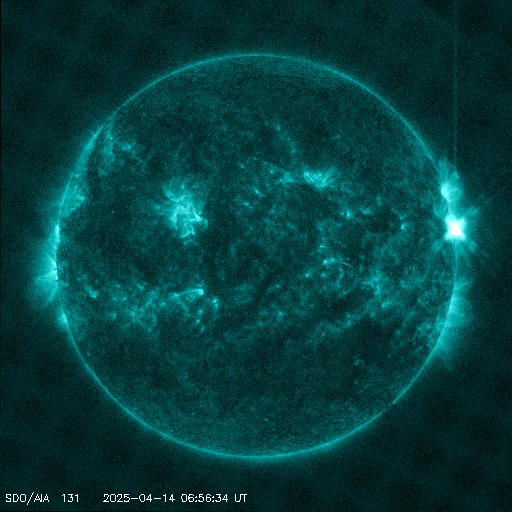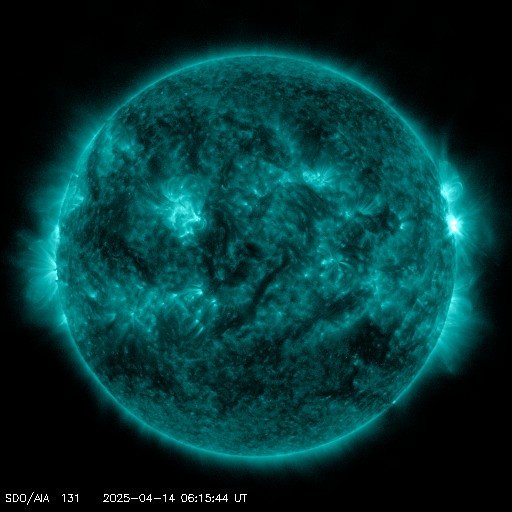Viewing archive of Wednesday, 5 December 2018
Daily bulletin on solar and geomagnetic activity from the SIDC
Issued: 2018 Dec 05 1230 UTC
SIDC Forecast
Solar flares
Quiet conditions (<50% probability of C-class flares)
Geomagnetism
Active conditions expected (A>=20 or K=4)
Solar protons
Quiet
| 10cm flux | Ap | |
|---|---|---|
| 05 Dec 2018 | 069 | 005 |
| 06 Dec 2018 | 070 | 005 |
| 07 Dec 2018 | 071 | 019 |
Bulletin
The solar activity has been quiet over the past 24 hours. The visible solar disc was spotless, and no significant flare has been recorded. A new bipolar sunspot group (Catania sunspot group 2) has emerged today, no significant flare has been recorded. Flaring conditions are expected to increase with as small change of C-class flare.
No Earth directed Coronal Mass Ejection has been observed. The greater than 10 MeV solar protons flux remained at nominal levels over the past 24 hours and is expected to remain so.
The solar wind measurements remained under the influence of the enhanced solar wind associated with the Coronal Hole (which reached the central meridian on November 27). The wind speed decreased to 415 km/s (December 4 around 13:00 UT), then re-increased and reached 500 km/s on December 4, around 19.00 UT. The interplanetary magnetic field strength fluctuated between 1.5 and 7 nT and the southward magnetic component between -4.8 and 5.2 nT. The solar wind parameters are expected to start to decrease to the slow solar wind regime. A large south polar coronal hole (of negative polarity) that extended up to latitude 10 degree North is currently facing Earth. The solar wind parameters are expected to be enhanced due to the fast solar wind associated with this coronal hole on the afternoon of December 7.
The geomagnetic conditions were quiet. The conditions are expected to be mainly quiet as the Earth is entering the slow solar wind speed regime. The geomagnetic conditions will then become more active due to the arrival of the fast solar wind.
Today's estimated international sunspot number (ISN): 016, based on 09 stations.Solar indices for 04 Dec 2018
| Wolf number Catania | /// |
| 10cm solar flux | 069 |
| AK Chambon La Forêt | 014 |
| AK Wingst | /// |
| Estimated Ap | 010 |
| Estimated international sunspot number | 000 - Based on 26 stations |
Noticeable events summary
| Day | Begin | Max | End | Loc | Strength | OP | 10cm | Catania/NOAA | Radio burst types | |
|---|---|---|---|---|---|---|---|---|---|---|
| None | ||||||||||
Provided by the Solar Influences Data analysis Center© - SIDC - Processed by SpaceWeatherLive
All times in UTC
Current data suggests there is a slight possibility for aurora to appear at the following high latitude regions in the near future
Gillam, MB, Whitehorse, YT, Yellowknife, NTAnchorage, AK, Fairbanks, AK, Juneau, AK
Latest news
Latest forum messages
Support SpaceWeatherLive.com!
A lot of people come to SpaceWeatherLive to follow the Sun's activity or if there is aurora to be seen, but with more traffic comes higher server costs. Consider a donation if you enjoy SpaceWeatherLive so we can keep the website online!

Latest alerts
07:09 UTC - Solar flare
Moderate M4.28 flare from sunspot region 4055
06:48 UTC - Radio Blackout
Minor R1 radio blackout in progress (≥M1 - current: M1.53)
06:24 UTC - Solar flare
Moderate M1.49 flare from sunspot region 4055
06:06 UTC - Radio Blackout
Minor R1 radio blackout in progress (≥M1 - current: M1.16)
04:45 UTC - Geomagnetic activity
Active geomagnetic conditions (Kp4) Threshold Reached: 04:29 UTC
Space weather facts
| Last X-flare | 2025/03/28 | X1.1 |
| Last M-flare | 2025/04/14 | M1.4 |
| Last geomagnetic storm | 2025/04/06 | Kp5 (G1) |
| Spotless days | |
|---|---|
| Last spotless day | 2022/06/08 |
| Monthly mean Sunspot Number | |
|---|---|
| March 2025 | 134.2 -20.4 |
| April 2025 | 132.1 -2.1 |
| Last 30 days | 132.4 -10.7 |





